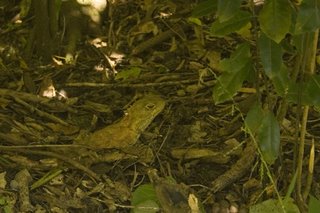
In total I spent about one week in Wellington, the capital city of New Zealand. In the last few years I've spent a lot of time in the wilderness on hiking trips and during field work, and so trips to cities are becoming more and more novel. I really enjoyed my time in Wellington, probably in part because the weather was really nice while I was there. The city reminds me of San Francisco, though smaller and less diverse. It has a large natural harbor, sits on a major fault and is sure to be decimated by a major earthquake at some point in the not-too-distant future, has a small island where they used to put inmates, has steep windy roads, lots of old wood houses, numerous cafes, and it has a climate similar to San Francisco. Both Wellington and San Francisco were built in a haphazard way - San Francisco by miners, Wellington by a city planner living in England who didn't consider topography in his design.

The view from Tom's apartment.
Wellington has many "secret staircases" that cut up and down the hills that make great shortcuts, as long as you know where you are going. Many houses don't have direct access to the road - some have little trams that you take you from the road to the house, others just have very long staircases. My favorite thing about Wellington was that it was very urban yet also very peaceful. In about 15 minutes you can walk from the city center to a heavily vegetated suburb. The houses sit close to each other, but you hardly notice your neighbors. The area is so lush that I got the impression that if you left town for a couple of months you might need a machete in order to "reclaim" your house.
The last day that I was in Wellington I went to the Karori Wildlife Sanctuary with the hope of spotting a tuatara, a very special reptile that has remained relatively unchanged over the past 200 million years. The tuatara, which is endangered, was once found throughout New Zealand but now only lives on remote islands with few predators. It has recently been brought to Karori Wildlife Sanctuary in an attempt to reintroduce it to the north island. I've been told that they reproduction rates are very low and that they grow slowly, making reintroduction a difficult task. However, they can live to be 100 years old. Check out the description of tuatara on wikipedia - they are really fascinating creatures.
Anyway, I got lucky and I was able to snap a few photos of a tuatara.

No comments:
Post a Comment